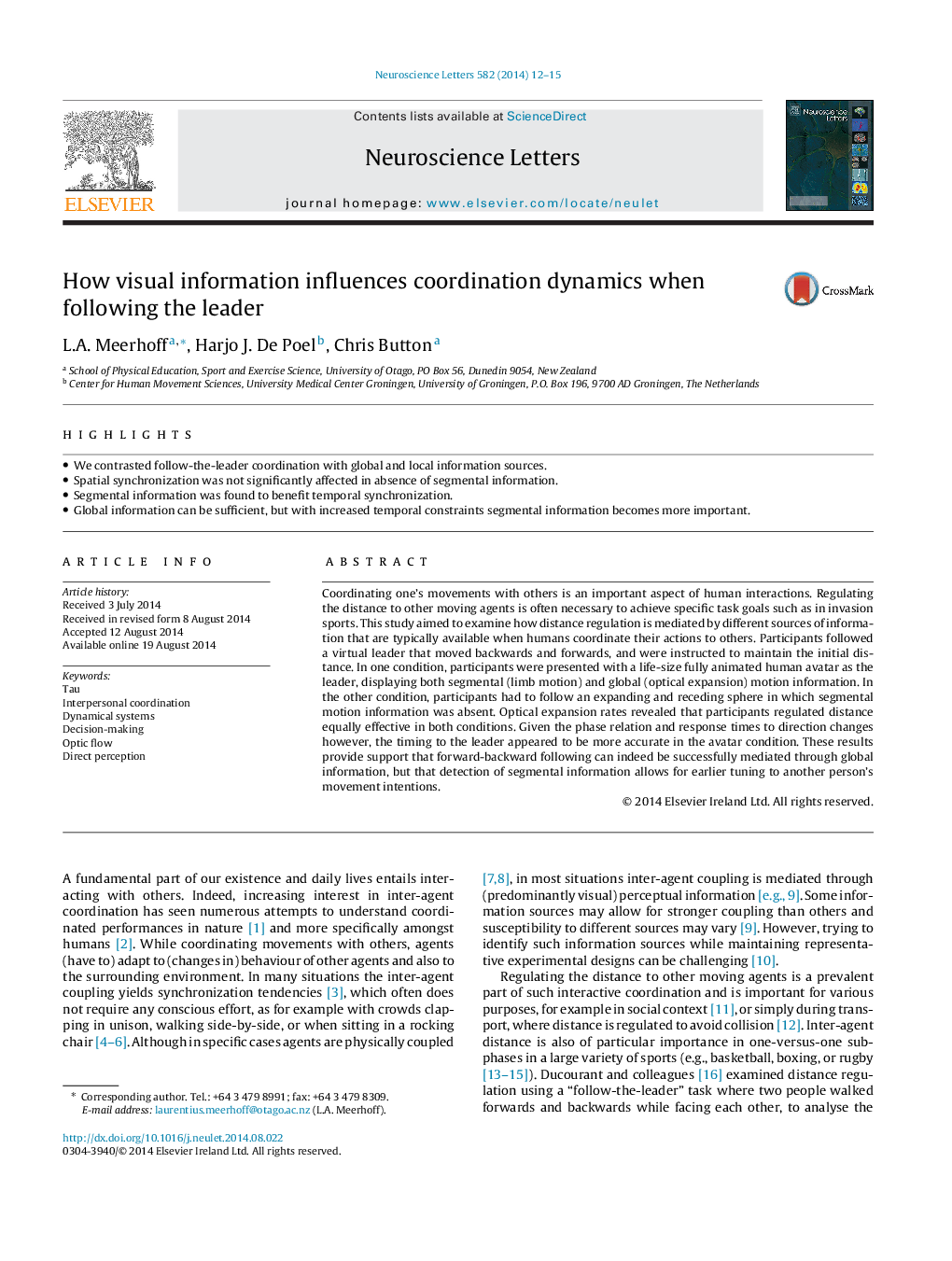| کد مقاله | کد نشریه | سال انتشار | مقاله انگلیسی | نسخه تمام متن |
|---|---|---|---|---|
| 6281630 | 1615117 | 2014 | 4 صفحه PDF | دانلود رایگان |
عنوان انگلیسی مقاله ISI
How visual information influences coordination dynamics when following the leader
ترجمه فارسی عنوان
چگونه اطلاعات بصری پس از رهبر بر روی تغییرات هماهنگ تاثیر می گذارد
دانلود مقاله + سفارش ترجمه
دانلود مقاله ISI انگلیسی
رایگان برای ایرانیان
کلمات کلیدی
تاو، هماهنگی بین فردی، سیستم های دینامیک، تصمیم سازی، جریان نوری، ادراک مستقیم،
ترجمه چکیده
هماهنگ کردن حرکات فرد با دیگران، جنبه مهمی از تعاملات انسانی است. تنظیم فاصله از سایر عوامل متحرک اغلب برای دستیابی به اهداف خاص کاری مانند ورزش در تهاجم ضروری است. این مطالعه با هدف بررسی چگونگی تنظیم مقررات فاصله از طریق منابع مختلف اطلاعات صورت می گیرد که به طور معمول در دسترس هستند وقتی انسان ها اقدامات خود را به دیگران هماهنگ می کنند. شرکت کنندگان یک رهبر مجازی را دنبال کردند که به عقب و جلو حرکت می کردند و دستور دادند فاصله اولیه را حفظ کنند. در یک شرایط، شرکت کنندگان با نماد انسان به طور کامل متحرک زندگی به عنوان رهبر ارائه شد، نشان می دهد هر دو بخش (حرکت اندام) و جهانی (گسترش نوری) اطلاعات حرکت است. در شرایط دیگر، شرکت کنندگان مجبور به دنبال یک حوزه در حال گسترش و فرار بودند که در آن اطلاعات حرکت قطعی وجود نداشت. نرخ گسترش نوری نشان داد که شرکت کنندگان مسافت را به طور موثر در هر دو شرایط کنترل می کنند. با توجه به رابطه فاز و زمان پاسخ به تغییرات جهت، با این حال، زمان به رهبر ظاهرا دقیق تر از شرایط نماد بود. این نتایج حمایتی را ارائه می دهد که در پی عقبنشینی می تواند با موفقیت از طریق اطلاعات بین المللی مداخله کند، اما تشخیص اطلاعات سگالال اجازه می دهد تا تنظیمات قبلی برای اهداف جنبش دیگری تعیین شود.
موضوعات مرتبط
علوم زیستی و بیوفناوری
علم عصب شناسی
علوم اعصاب (عمومی)
چکیده انگلیسی
Coordinating one's movements with others is an important aspect of human interactions. Regulating the distance to other moving agents is often necessary to achieve specific task goals such as in invasion sports. This study aimed to examine how distance regulation is mediated by different sources of information that are typically available when humans coordinate their actions to others. Participants followed a virtual leader that moved backwards and forwards, and were instructed to maintain the initial distance. In one condition, participants were presented with a life-size fully animated human avatar as the leader, displaying both segmental (limb motion) and global (optical expansion) motion information. In the other condition, participants had to follow an expanding and receding sphere in which segmental motion information was absent. Optical expansion rates revealed that participants regulated distance equally effective in both conditions. Given the phase relation and response times to direction changes however, the timing to the leader appeared to be more accurate in the avatar condition. These results provide support that forward-backward following can indeed be successfully mediated through global information, but that detection of segmental information allows for earlier tuning to another person's movement intentions.
ناشر
Database: Elsevier - ScienceDirect (ساینس دایرکت)
Journal: Neuroscience Letters - Volume 582, 17 October 2014, Pages 12-15
Journal: Neuroscience Letters - Volume 582, 17 October 2014, Pages 12-15
نویسندگان
L.A. Meerhoff, Harjo J. De Poel, Chris Button,
